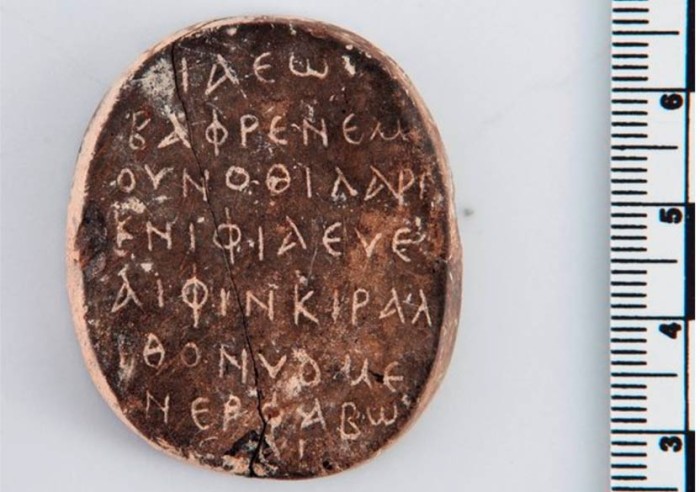
A team of Polish archeologists in Nea Paphos, Cyprus has recently unearthed a 1,500-year-old, two-sided amulet depicting a palindrome inscription written in ancient Greek.
Palindromes are phrases that are read the same both forward and backwards.
The amulet’s 59-letter inscription reads:
“ΙΑΕW ΒΑΦΡΕΝΕΜ ΟΥΝΟΘΙΛΑΡΙ ΚΝΙΦΙΑΕΥΕ ΑΙΦΙΝΚΙΡΑΛ ΙΘΟΝΥΟΜΕ ΝΕΡΦΑΒW ΕΑΙ,” which roughly translates to “Iahweh [a god] is the bearer of the secret name, the lion of Re secure in his shrine.”
Although written in ancient Greek, there are a number of spelling errors, indicating the creator and owner of the object were not educated or may not have been native Greek speakers.
Ancient amulet found in Cyprus features ancient Greek, Egyptian gods
The amulet is particularly unique and strange in that it features a fascinating image on the other side, which includes references to ancient Egyptian and Greek gods.
On the other side of the palindrome, the amulet features three main images, one of the ancient Egyptian god Osiris lying in a boat, a cynocephalus, or a god with the head of a dog, and the body of a man and the ancient Greek god of silence, Harpocrates, sitting on a stool.
A crocodile, snake, moon, and star are also shown on the amulet.
Osiris, who is depicted on the amulet wrapped up like a mummy, was the Egyptian god of the underworld.
Perhaps, most strangely, Harpocrates is depicted holding his hand up to his lips, and the cynocephalus is shown doing the same, mimicking the gesture of the god.
Both the cynocephalus and Harpocrates are shown with lines across their bodies, perhaps indicating that they, like Osiris, were meant to be mummified.
In the case of the cynocephalus, there are images of the creature mummified. Yet, Harpocrates is never depicted in this way anywhere else.
This may indicate that the creator of the amulet was not familiar with the religious imagery surrounding Harpocrates, but knew how to depict the ancient Egyptian figures.
Christianity was official religion at the time
Amulets such as this were used for protection since ancient times in many pagan beliefs.
During the sixth century, when the amulet was found, Christianity was the official religion of Cyprus. Yet, clearly, pagan beliefs were still quite strong in the country during the period.
The artifact was found in a 2015 dig at the ancient agora of Nea Paphos of southwest Cyprus, where archaeologists have been working for a long time.
The agora used to operate as a gathering place for the worship of the ancient goddess, Aphrodite.
“Paphos, which has been inhabited since the Neolithic period, was a center of the cult of Aphrodite and of pre-Hellenic fertility deities,” noted UNESCO. “Aphrodite’s legendary birthplace was on the island of Cyprus, where her temple was erected by the Mycenaeans in the 12th century BC and continued to be used until the Roman period.”
See all the latest news from Greece and the world at Greekreporter.com. Contact our newsroom to report an update or send your story, photos and videos. Follow GR on Google News and subscribe here to our daily email!



